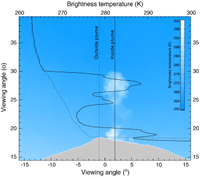Quantitative imaging of volcanic plumes — Results, needs, and future trends
Platt U., P. Lübcke, J. Kuhn, N. Bobrowski, F. Prata, M. Burton, C. Kern (2015).
Journal of Volcanology and Geothermal Research, Volume 300, Pages 7-21, doi:10.1016/j.jvolgeores.2014.10.006.
Abstract
Recent technology allows two-dimensional “imaging” of trace gas distributions in plumes. In contrast to older, one-dimensional remote sensing techniques, that are only capable of measuring total column densities, the new imaging methods give insight into details of transport and mixing processes as well as chemical transformation within plumes. We give an overview of gas imaging techniques already being applied at volcanoes (SO2 cameras, imaging DOAS, FT-IR imaging), present techniques where first field experiments were conducted (LED-LIDAR, tomographic mapping), and describe some techniques where only theoretical studies with application to volcanology exist (e.g. Fabry–Pérot Imaging, Gas Correlation Spectroscopy, bi-static LIDAR). Finally, we discuss current needs and future trends in imaging technology.
http://www.sciencedirect.com/science/article/pii/S0377027314003047


